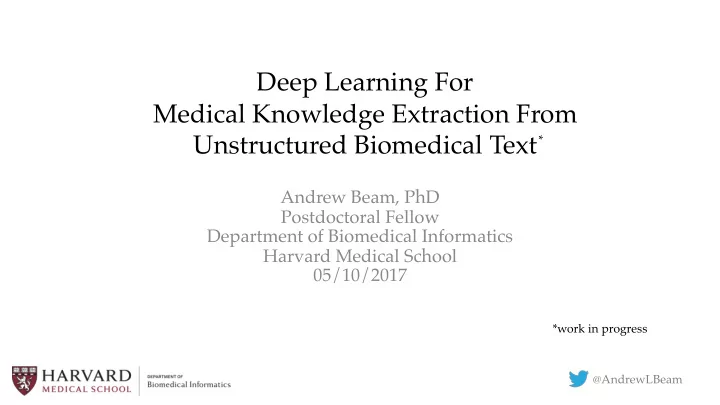

Deep Learning For Medical Knowledge Extraction From * Unstructured Biomedical Text Andrew Beam, PhD Postdoctoral Fellow Department of Biomedical Informatics Harvard Medical School 05/10/2017 *work in progress @AndrewLBeam
AI & MEDICINE AI has the potential to fundamentally change healthcare and medicine… … but how do we measure the progress of AI for general medical diagnosis*? *outside of medical imaging
THE DOCTOR BASELINE MDs often serve as the comparison for medical AI, but setting up a fair comparison is harder than it seems != Image credit: http://www.bbc.com/news/magazine-28166019
THE DOCTOR BASELINE Doctors Don’t Predict Doctors don’t : • - Predict appearance of diagnoses in the future - Provide calibrated probabilities - Optimize for AUC Doctors do : • - Infer current disease state given symptoms - Triage patients given current estimate of disease state
THE DOCTOR BASELINE Doctors Disagree • Doctors often disagree about the correct diagnosis for a given patient • Even the correct list of diagnoses to consider (e.g. the differential) is often not unanimous • Thus, an objective “gold standard” dataset of labeled patients can be very hard to create in some instances.
THE DOCTOR BASELINE Healthcare Data is Messy • In most healthcare data (e.g. EHR/claims) you don’t observe the disease process directly, but instead the process of healthcare dynamics • Information leakage is inevitable • Doctor reasoning process is “baked in”, can’t take the doctor out of the data • How will an AI system trained on one EHR generalize to a new one? Image credit: Griffin Weber, MD/PhD
BENCHMARKING MEDICAL AI Desirable Benchmark Properties Clarity: Unambiguous gold standard • Portability: Easy to compare results across different • healthcare environments and populations Comparability: Available metrics of human performance • Goal: Task that doctors actually do that also meets these criteria
USMLE STEP 1 U nited S tates M edical L icensing E xamination Exam administered in 3 “steps” Step 1 is taken after the 2 nd year of medical school - - Requires several months of dedicated study - Tests understanding of fundamentals of biology and clinical medicine - Multiple-choice format - Large influence on residency placement - “SAT” for med students Necessary (but not sufficient) condition for becoming a physician
STEP 1 AND AI Step 1 is an attractive benchmark for medical AI Requires broad knowledge of medicine and biology • Unambiguous right/wrong answers (clarity) • Potentially free from healthcare data “messiness” • (portability) 25,000 medical students take it each year -> good human • performance numbers (comparability) It’s hard and will require methodological innovation • Con : Unclear road to clinical tool •
OVERVIEW Can we train a deep learning system capable of passing step 1? Step 1 Question A full-term female newborn is examined shortly after birth … Which of the following mechanisms best Unstructured explains this cytogenetic abnormality? Medical Text Answer Probabilities (A) (B) (C) (D) (E) Answers (A) Nondisjunction in mitosis (B) Reciprocal translocation (C) Robertsonian translocation (D) Skewed X-inactivation (E) Uniparental disomy
DATA RESOURCES Biomedical Journal Articles Test Preparation PMC Open Access – 1.7M Flash cards Biomedical Knowledge Elsevier – 2M High Yield Concept List Commons Springer – 500K Books 4.3M articles • 50,000 pages of reference • material Physician References 15,000 flash cards • Dozens of books Merck Manuals • Step 1 Questions 10,000 Step 1 style questions • Mayo Clinic Disease Library Open Osmosis MEDLINE All preprocessed and normalized Library Resources DynaMed against a common medical NBME Emedicine/Medscape thesaurus
DATA PREPROCESSING Raw Text Normalization MED2VEC
MED2VEC What can we learn about medical concepts from 4.3 million journal articles?
MED2VEC Query Compute Similarity bronchopulmonary Medical Concept Vector Database dysplasia 60,000 medical concepts
WHAT DRUGS ARE USED FOR BPD? Query Rank bronchopulmonary dysplasia Filter Pharmacologic Substance
HOW IS BPD MANAGED? Query Rank bronchopulmonary dysplasia Filter Therapeutic or Preventive Procedure
DEEP LEARNING FOR QA Approach: Deep neural network that maps word vectors in question -> correct answer End-to-end deep learning QA systems need 100k – 1M QA pairs. Existing SOTA operate in an “easier” domain (e.g. Who is Obama’s wife?) 10,000 questions are not enough. We need a way to generate more questions.
SYNTHETIC QUESTIONS Scan through entire corpus Extract Potential QA pair Score Synthetic QA Pairs Using UMLS NLP/POS tagger: Compare semantic similarity of - Tag noun-phrases that synthetic QA pairs against real mention medical concepts as ones. potential answers - Surrounding sentences as Only keep high scoring synthetic potential question QA pairs. - Each QA pair becomes a potential fill in the blank question. Results: 1 billion potential QA pairs
MODEL OVERVIEW Q: It is associated with notching of the ribs because of Recurrent Layer collateral circulation hypertension in the upper y = 1 Pr(postductal coarctation is correct | Q) Dense Layer extremities and weak pulses in the lower extremities. _____ is most likely the result of the extension of a muscular artery ductus arteriosus into an elastic artery aorta during fetal life where the contraction and fibrosis of the ductus arteriosus upon birth subsequently narrows the aortic lumen. QA Embedding Question Encoder Answer Encoder … … [ 0.1,3.9,4.5,-3.1,0.2 ] [ 0.1,-2.3,4.0,5.1,-6.5 ] [- 1.1,-4.3,-8.0,-5.1,-6.5 ] [ 1.1,-0.3,-3.0,-2.1,-6.5 ] … Answer: It is lumen coarctation postductal Postductal Coarctation Work is on going!
CONCLUSIONS - Thoughtful metrics of progress for medical AI are vitally important - Head to head comparisons with doctors can be tricky - Step 1 may be a good benchmark for medical AI - Unsupervised learning on large sources of biomedical text can automatically extract relationships between medical concepts - Deep learning has promise for answering step 1 questions
ACKNOWLEDGEMENTS Harvard Medical School Funding Hardware Inbar Fried Sam Finlayson Nathan Palmer Isaac Kohane Google Brain Data Jasper Snoek Alex Wiltschko @AndrewLBeam
Recommend
More recommend